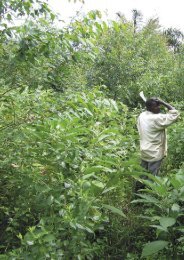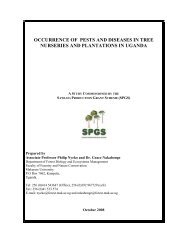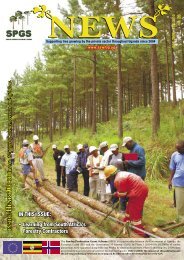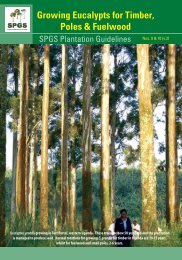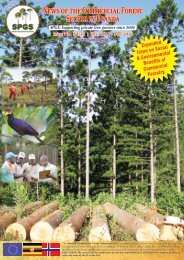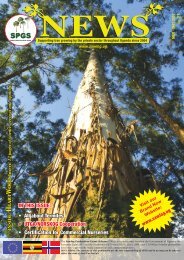Create successful ePaper yourself
Turn your PDF publications into a flip-book with our unique Google optimized e-Paper software.
HeartWood<br />
No. 6 (2010)<br />
12 PAGES OF SCIENCE, REVIEWS AND OPINIONS<br />
PROTECTIVE CLOTHING –<br />
THE LAST LINE OF DEFENCE<br />
by Walter Mapanda, <strong>SPGS</strong> Plantations’ Technical Advisor<br />
Use of Personal Protective Clothing b) Protective equipment such as safety<br />
(PPE) makes hazards at the work goggles and respirators (Health Working<br />
place more manageable. Provisions Lives, 2010).<br />
of PPE coupled with PPE training Forestry has consistently been one of the<br />
programmes enhance employees feelings<br />
about the level of safety and security<br />
within their work environment which in<br />
turn improves the organisation’s business<br />
most hazardous industries in the world. For<br />
example, in 2008 the United States logging<br />
industry employed 86 000 workers of which<br />
93 died as a result of accidents associated<br />
performance. PPE provision and training with forestry operations. This resulted in<br />
programmes improve productivity by a fatality rate of 108.1 deaths per 100 000<br />
minimizing worker and process downtime<br />
(Reliable Plant, 2010). Small investment in<br />
PPE and PPE training serves the employers<br />
a lot of money by offsetting costs resulting<br />
workers which is more than 30 times higher<br />
than the overall fatality rate in workplaces<br />
of 3.5 deaths per 100 000 in the US in 2008<br />
(Centers for Disease Control and Prevention,<br />
from injuries, chronic health problems and 2010). British Columbia Forest Safety<br />
potential workplace fatalities.<br />
Unfortunately, however, in Uganda there are<br />
few employers who provide their employees<br />
Council (2010) compiled five year fatalities<br />
statistics for harvesting operations shown in<br />
Table 1 below.<br />
Table 1. Fatalities in Harvesting in British Columbia 2006-2010<br />
HARVESTING OPERATION<br />
YEAR<br />
2006 2007 2008 2009 2010<br />
Log Hauling 5 1 3 0 2<br />
Yarding / Mechanised Harvesting 2 4 0 1 0<br />
Travelling to and from work 0 3 3 0 0<br />
Manual Tree Felling 0 1 8 2 0<br />
Other 4 2 2 1 0<br />
Direct Fatalities Total 11 11 16 4 2<br />
Source: British Columbia Safety Council (August 2010)<br />
IN THIS ISSUE:<br />
• Investment Opportunities<br />
for Tree Growers in Uganda<br />
• Training Needs Report<br />
• New Tree Species for Trials<br />
in Uganda<br />
• Lots of Interesting Reviews<br />
with PPE. Most of those that provide PPE<br />
do so without linking it to other measures<br />
which protect workers from health and safety<br />
hazards. This article defines PPE, explains<br />
the importance of PPE and the relationship<br />
of PPE to other health and safety protection<br />
measures.<br />
PPE is all equipment (including clothing<br />
affording protection against the weather)<br />
which is intended to be worn or held by a<br />
person at work which protects them against<br />
one or more risks to their health and safety.<br />
PPE includes:<br />
a) Protective clothing such as safety shoes,<br />
hard hats, overalls, gloves, high visibility<br />
waistcoats and clothing which protects<br />
against the weather.<br />
From the above results it is clear that most<br />
fatalities occured in log hauling and manual<br />
tree felling section. Workers compensation<br />
premiums are affected by injury frequency as<br />
well as severity. Therefore, the more injuries<br />
a company has, the higher is its premiums.<br />
PPE and PPE training reduces injury frequency<br />
and severity (Benjamin, 2010).<br />
An injury that could occur in a forestry<br />
organization would consist of “direct”<br />
and “indirect” costs. Direct costs include<br />
ambulance services, emergency room care,<br />
examination by a doctor, medication,<br />
hospitalization and temporary disability<br />
benefits. Indirect costs are normally<br />
approximated to be three or four times the<br />
direct cost.<br />
Walter at the <strong>SPGS</strong> Clients’ Meet, July, 2010<br />
Indirect costs include the following:<br />
• Cost of lost time of the injured employee.<br />
• Cost of lost time of the employees who<br />
stopped work to attend to the injured.<br />
• Cost of lost time to conduct an<br />
investigation.<br />
• Cost of training a new employee to fill in<br />
for the injured employee.<br />
• Cost of training the injured employee to<br />
perform a new job while recovering.<br />
• Cost due to damage to machinery, tools,<br />
and other property.<br />
1



